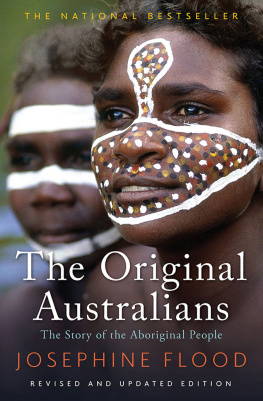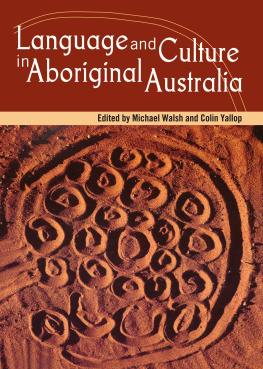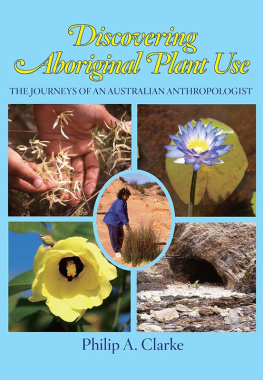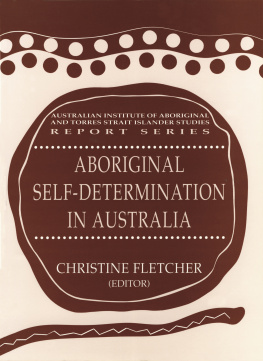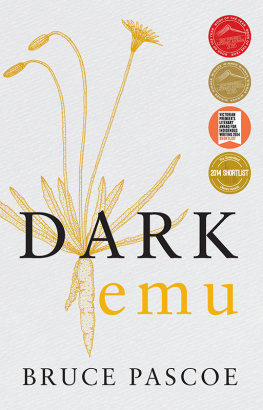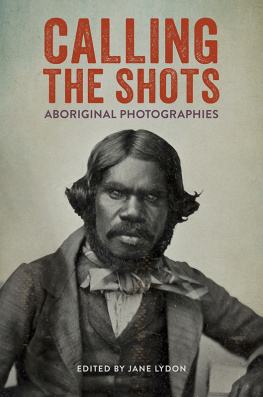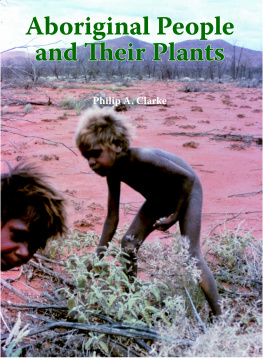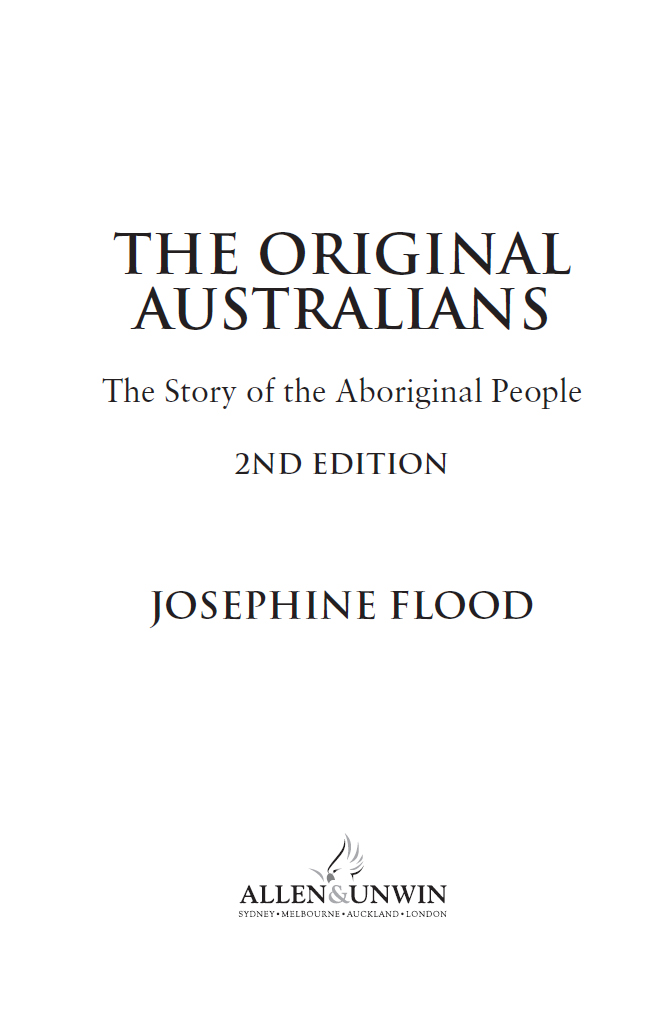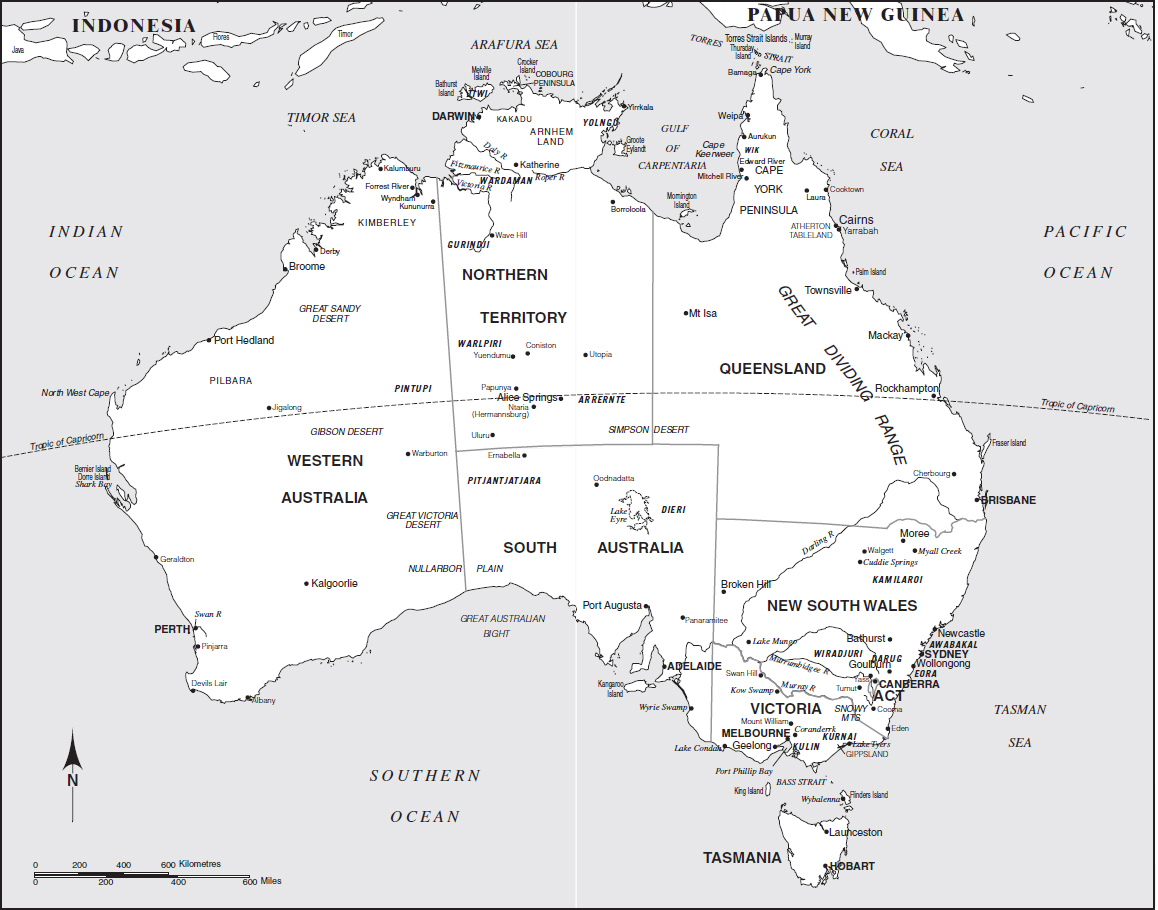This edition published in 2019
First published in 2006
Copyright Josephine Flood 2006
All rights reserved. No part of this book may be reproduced or transmitted in any form or by any means, electronic or mechanical, including photocopying, recording or by any information storage and retrieval system, without prior permission in writing from the publisher. The Australian Copyright Act 1968 (the Act) allows a maximum of one chapter or 10 per cent of this book, whichever is the greater, to be photocopied by any educational institution for its educational purposes provided that the educational institution (or body that administers it) has given a remuneration notice to the Copyright Agency (Australia) under the Act.
Allen & Unwin
83 Alexander Street
Crows Nest NSW 2065
Australia
Phone: (61 2) 8425 0100
Email:
Web: www.allenandunwin.com

ISBN 978 1 76052 707 5
eISBN 978 1 76087 142 0
Maps by Map Graphics, Brisbane
Index by Puddingburn Publishing Services
Typeset by Midland Typesetters, Australia
Cover design: Nada Backovic
Cover photograph: Penny Tweedie / Getty Images
This book is dedicated to the Aboriginal people of Australia, who for the last 50 years have been generously and patiently teaching me about their traditional life, culture and history.
CONTENTS
The Original Australians tells the story of Australian Aboriginal history and culture from their distant beginnings to the present day. As an archaeologist, my aim is to try to explain what happened in the past and place traditional Australian indigenous societies into their global context. My mission is to present an accurate, objective, informative account of this continents first inhabitants. Australia is a country where, for archaeologists, the ancient past and the present converge, for it is here that people survived through major climatic changes, suffered huge loss and pain as a result of European colonisation, and, almost against the odds, managed to maintain their cultural identity, now recognised and respected throughout the world. The resilience of Australias Aboriginal people is one of the great human stories of all time.
During a 50-year-long career as an archaeologist in Australia, I have excavated ice-age caves, searched the landscape for ancient campsites and recorded rock paintings and their meanings. In that time, I have worked with many Aboriginal people especially in the Northern Territory and admire and respect them. They have suffered much, yet have survived, bridging the gap between their culture and history and the contemporary world.
Of course, the Aboriginal story has not finished, and I bring it up to the present, covering current issues and hopes for the future. The most difficult section of this book to write has been the story of the last two centuries, for recent history has become extremely polarised. In the 1980s, a critical view of Australian history arose among a younger band of historians in reaction to an earlier self-congratulatory approach. Henry Reynolds book The Other Side of the Frontier pioneered this new direction of committed history. Reynolds strong sympathy for Aboriginal victims led to him and his followers being dubbed black armband historians by Geoffrey Blainey, a distinguished historian of the older school. Blaineys book Triumph of the Nomads is an extremely positive portrayal of traditional Aboriginal society, but by 1993 he considered historical writing in Australia had swung from a position that had been too favourable, too self-congratulatory, to an opposite extreme that [was] even more unreal and decidedly jaundiced. Blainey agreed that the treatment of Aborigines was often lamentable but was disturbed by mischievous statements that the Aborigines numbers were drastically reduced primarily by slaughter. In fact, diseases were the great killer by a very large margin. (One reason I wrote this book was to evaluate this claim.) In 2002, Sydney historian Keith Windschuttle published The Fabrication of Aboriginal History, Vol. 1, Van Diemens Land 18031847 and sparked off what are known as the History Wars between left- and right-leaning historians. Much heat and personal invective surround questions such as exact casualty figures, which both sides concede can never be accurately known. One positive result of all this verbal violence has been that it has made some historians re-evaluate earlier work; but sadly a genre of revisionist history has developed that ignores proven facts to build a false history of warfare and genocide, which hinders rather than helps the path to reconciliation. Many of the general public now have no idea what to believe, which is why in this book I concentrate on generally agreed facts and how we know what we know.
This book, like my previous ones, has been written in response to a specific request, this time from overseas friends planning their first visit and wanting an introduction to indigenous Australia. I searched the bookshops but found nothing suitable that dealt with both the past and the present. My goal in writing, therefore, is to provide an up-to-date account that answers the most commonly asked questions about the First Australians.
My target audience is the general public, especially those who would like to try to understand Australian Aboriginal society from a wide perspective, whether their interest lies in origins, traditional life and art or more recent history. I have also written for those readers who, like me, grew up elsewhere and didnt study Australian history at school. Some may say that only Aborigines should write about Aboriginal Australia, but the reality is that the interests of the few indigenous historians or archaeologists usually lie in other areas, such as oral history and autobiography. Inevitably, my viewpoint is different and I tell the story from an outsiders perspective, based on research, knowledge and experience gained in Aboriginal studies since I emigrated to Australia in 1963.
My first step was to ask family and friends in Australia, Britain and the United States for lists of questions. Replies were equally divided between past and present, leading me on a fascinating seven-year-long detective hunt. After several false starts I almost gave up the concept, until I recalled the words of Goobalathaldin (Dick Roughsey) round a campfire in Cape York: I want to hear the whole story. Where shall I begin? I asked. Begin at the beginning, he replied. In previous books on Australian archaeology and rock art I had taken the beginning as the moment, some 65,000 years ago, when the first human footprint appeared on an Australian beach. This time Aboriginal society is revealed to the reader as it was gradually discovered by the outside world. My tale therefore begins with first contact between foreigners and Aborigines.
My interests lie in the why rather than the what of history. As polar explorer Apsley Cherry-Garrard said, The best stories are not what people do, but why they do it. I therefore seek to understand both white and black motives for past actions, such as why Aboriginal responses to outsiders were so varied or why a treaty was made with the indigenous people of New Zealand but not Australia. Of course, causes of past events must be seen in the context of their time, not through the lens of the twenty-first century. We must constantly remind ourselves of the first explorers and colonists total ignorance about Aboriginal society. Only very slowly did understanding improve. In Australia the discipline of anthropology is barely a century old and archaeology is even younger. While this book summarises modern understanding about traditional Aboriginal Australia, it seeks to explain past events in their own context rather than with the benefit of hindsight.

